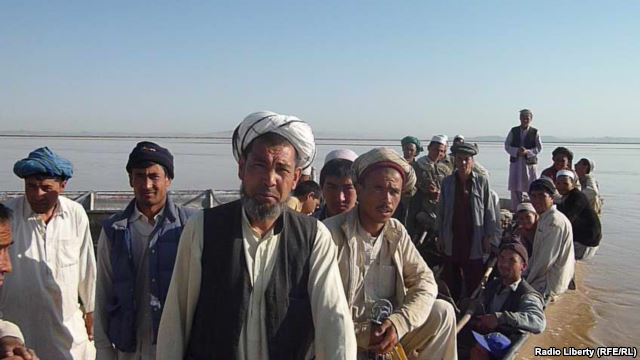
Afghanistan’s Ethnic Turkmens: Enemies or Allies for Ashgabat?
Publication: Eurasia Daily Monitor Volume: 12 Issue: 67
By:

The relationship between Afghanistan’s Turkmen diaspora and Turkmenistan has always been complicated as well as under-researched. However, the latest developments along the Turkmenistan-Afghanistan border helps to shed some light on the situation in this strategically important territory.
Within those Afghan provinces that border Turkmenistan, the population of Faryab is composed of as many as 7 percent Turkmens, while this ethnic group makes up around 3 percent in Badghis province. Data on Jowzjan province is unavailable, but it is known that Turkmens represent the majority of the local population (Chrono-tm.org, April 23, 2013; Asgabat.net, April 10, 2015).
When the Taliban began attacking communities along the Turkmenistan-Afghanistan border, in 2014, some Afghan Turkmens responded. Former ethnic-Turkmen warlord Gurbandurdy, from Karkin in Jowzjan province, gathered his followers to defend the village by setting up checkpoints and actively fighting back against the Taliban. According to Gurbandurdy, the Taliban started killing and kidnapping people around his village, prompting him to take up arms again. He and his forces expected Ashgabat to provide some assistance with reinforcing the border infrastructure; however, no concrete steps had been taken so far (12News.uz, March 21, 2014).
Officials from Turkmenistan’s border service confirm that the Gurbandurdy forces’ defensive measures have kept that particular part of the inter-state border relatively safe, stable, and free from drug trafficking. But the question remains whether Ashgabat ever rendered any serious border protection assistance to its Afghan diaspora, or whether such assistance might be underway along other parts of the border (Gundogar, March 12, 2014).
Gurbandurdy’s Karkin village is now under attack from Afghan police authorities who, on March 16, opened fire on the villagers, in response to local protests. The shooting left three people dead, with many more heavily wounded. Residents were protesting Turkmenistani border guards’ actions to expel the villagers from an island on the Amu Darya river; this land had previously constituted an integral part of Karkin. The island appeared as a result of large portions of the river bank collapsing on the Afghan side of the border. For many years, Karkin’s population suffered from the destructive forces of the Amu Darya, which regularly flooded their grazing lands. The population has repeatedly requested help from authorities in both Turkmenistan and Afghanistan, but to no avail. Now, the island has turned into disputed territory since the Amu Darya’s bank collapse has shifted the border, formed naturally by the river, between Afghanistan’s Jowzjan province and Turkmenistan. Karkin villagers use the island for grazing their livestock and collecting brushwood. However, Turkmenistani border guards have started building barrier lines and wire entanglements on the island, considering it part of the border zone. Villagers first protested these developments on February 27, after which Kabul promised to resolve the situation on an inter-governmental level, but so far nothing has changed (Habatm, March 16).
Gurbandurdy is not the only one opposing the Taliban along the Turkmenistan-Afghanistan border. Another militia of about 100 fighters was formed in Faryab province under the leadership of Emir Karyad who, like Gurbandurdy, is a former field commander who fought against the Soviet Union. In recent months, the Taliban has been attempting to radicalize and recruit the youth of Karyad’s village. Both commanders were urged by their village elders to establish militias to protect their communities; and both fully expect that Taliban forces will strike again in the near future. In response to this threat, Kabul had promised to supply local Turkmen militias with weaponry and ammunition as well as to pay them regular wages (TopTJ.com, September 1, 2014).
Similarly to the situation in Karkin, in early summer 2014, Turkmenistani border guards advanced on the Faryab province village of Qaysar to install more obstructive wire entanglements and dig a ditch along the border, four meters in width, expelling and depriving locals of vital grazing pastures. In addition, Turkmenistan is constructing new road infrastructure in the border area (Habartm, September 17, 2014). These unlawful invasive actions of Turkmenistan’s border guards reveal that Ashgabat is closely monitoring the local security situation and taking increasingly concrete steps to protect the border, even at the expense of local Turkmen populations on the Afghan side, who have no real recourse.
Turkmenistan’s growing concern about the security situation at the border has pushed the government, last year, to halt freight train service between Serhetabat and Towrgondi, in Afghanistan’s Herat province (12News.uz, March 21, 2014). Similar apprehension is now also pushing Turkmenistan’s military to boost its own ability to respond to such threats and overcome systemic issues of under manning in army units. According to some unofficial estimates, more than 800,000 Turkmenistanis of working age are currently abroad. Therefore, Turkmenistan’s Armed Forces have begun recruiting men in their mid-30s who had previously already served as conscripts, for tours of duty lasting 40 days. Moreover, migration and border services have closed the borders to prevent any males of recruitment age from leaving the country to seek work outside Turkmenistan. Even students returning home for short vacations from their studies abroad are banned from leaving the country. In addition, the term for active military service for males with higher education was prolonged to two years (Centrasia.ru, April 7, 2015).
Other serious problems of Turkmenistan’s military include severe lack of discipline, heavy corruption, acts of violence and harassment among servicemen (dedovshchina), and other disruptive factors. Officers unwilling to serve in Mary province, which borders Afghanistan, simply retire from military service if their requests for transfer to safer districts is denied; since the start of the year, more than 100 officers left their ranks. As of January 2015, due to dedovshchina, eight recruits committed suicide and another 45 suffered serious health problems, becoming permanently disabled (Centrasia.ru, April 7).
Russian analysts overwhelmingly conclude that the Taliban’s activities along the Turkmenistan-Afghanistan border are in preparation to infiltrate post-Soviet Central Asia with the purpose of creating a caliphate there and to obtain access to the region’s abundant natural resources (Chronika Turkmenistana, February 2, 2015). And while Turkmenistan’s Armed Forces may not be ready to face this challenge, local Turkmen militia on the Afghan side of the border—who stand in the Taliban’s way—remain largely scattered, with weak connections between each other. Local militia commanders like Gurbandurdy only protect areas relevant to them and may not be able to extend their forces elsewhere along the border. Yet, despite growing understanding of the threat along Turkmenistan’s southern border, to date Ashgabat has failed to successfully reach out to and engage Afghan Turkmens (Centrasia.ru, February 16).




